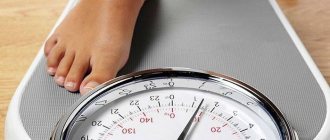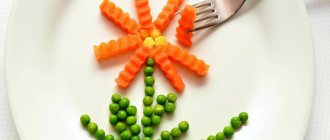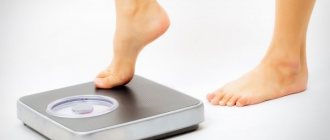How much weight can you really lose in a month?
Losing excess weight in a month is a very real task.
The main thing is not to place high hopes on extreme diets and not to subject the body to stress in the form of starvation and excessive physical activity.
It is important to know! An acceptable rate of weight loss is no more than 0.8-1 kg per week. By following the right diet and playing sports, you can safely get rid of 5 kg in 4 weeks for your body.
table of optimal weight and height for women and men
How much can you lose without exercise and on proper nutrition in a month?
Limiting your calorie intake and eliminating certain foods from your diet will help you get rid of fat deposits and improve the condition of your skin and overall appearance.
Without sports activities, the path to the desired goal will not be as fast as we would like , but still, following a healthy diet and changing eating habits will be beneficial and your figure will gradually change for the better.
Without sports activities, the path to the desired goal will not be as fast as we would like.
The transition to proper nutrition requires compliance with a number of rules:
- Avoid fatty foods and limit your consumption of fried foods. They fill you up quickly, but contain a large amount of calories.
- Avoid sweet bars and treats containing a lot of sugar. They can be replaced with dark chocolate, dried fruits, fruits and berries that contain many vitamins (apples, bananas, strawberries, etc.).
- Be sure to get into the habit of eating breakfast. During breakfast, metabolic processes in the body are launched, which help speed up metabolism. A breakfast rich in proteins, fats and carbohydrates will give you an energy boost for the whole day.
- Drink at least 2 liters of clean water per day. Water will speed up your metabolism and also help eliminate waste and toxins. Limit coffee consumption and completely eliminate alcohol, which retains water in the body and poisons the body as a whole.
- There should be several meals during the day. Small portions are digested faster, metabolism is accelerated and fat deposition is prevented.
Proteins, fats and carbohydrates are needed by the body equally; they all participate in the breakdown of fat.
The following foods rich in them are allowed:
- Proteins – dairy products, meat, fish, eggs.
- Fats - oils (olive, flaxseed), nuts, wholemeal bread, fatty fish, meat, seafood.
- Carbohydrates – root vegetables, vegetables, legumes, cereals.
Eating habits are quite easy to change, the main thing is to follow a diet and adhere to your BJU norm.
You won’t be able to quickly lose weight with proper nutrition in a month, but this is the most effective way to get into shape for a long time.
On a vegetarian diet
The basic rule of following a vegetarian diet is the limitation or exclusion of animal fats and proteins from the diet.
Vegetarian nutrition involves a gradual transition to plant foods.
This diet will help start the process of complete renewal of the body and natural fat burning. In a month of competent adherence to nutritional principles, you can lose 8 kg.
The basic rule of following a vegetarian diet is the limitation or exclusion of animal fats and proteins from the diet. They can be replaced with vegetable protein, milk fats, and eggs.
It is also recommended to add vegetable oils to food, such as sesame, coconut, and corn.
Excellent sources of polyunsaturated fats are nuts (cashews, almonds, hazelnuts).
Protein on a vegetarian diet is obtained from cottage cheese, a small amount of chicken eggs (no more than 3 per week).
It is recommended to exclude sugar and salt completely . Dishes can be seasoned with a little lemon juice or natural seasonings. Sugar and sweet treats are replaced with fruits and natural honey.
It is important to remember about water - drink at least 2 liters per day.
Sample menu for the day:
- Breakfast – 1 boiled egg, vegetable salad with beans, seasoned with 1 tbsp. l. lemon juice.
- Lunch – rice with vegetables, bread (50 grams).
- Snack – sweet fruits (200 grams).
- Dinner – cottage cheese, kefir.
Be sure to read: How to lose weight in 2 days: advice from models, diets and other remedies
On a protein diet
A protein diet is based on eating a large amount of protein-rich foods and cutting back on carbohydrates.
It is important to remember about water - drink at least 2 liters per day
In a month of following the diet, you can lose up to 10 kg, which will not return.
The main feature of this diet is that the body, which does not receive enough carbohydrates for a certain time, begins to use up its own fat reserves.
For 4 weeks, a protein diet does not harm the body, but you should not abuse it for longer.
A monotonous diet can cause a slowdown in metabolic processes, deterioration of well-being, and even negatively affect the condition of the kidneys due to the high concentration of protein.
Principles of a protein diet:
- Exclusion from the diet of flour, sweets, and fatty foods. These products include pasta, potatoes, vegetable oil and butter.
- Input of foods such as: low-fat dairy products, vegetables, eggs, lean meat and fish.
- The break between meals is no more than 2 hours. Such a nutritional scheme will put metabolic processes in the body in order.
- Compliance with drinking regime. You should drink as much pure water as possible while following a protein diet. You don’t have to limit the consumption of coffee and tea at any time of the day, but don’t add sugar or milk to drinks.
You can include foods such as:
- lean beef;
- skinless chicken breast;
- seafood;
- lean fish;
- tofu cheese;
- low-fat cottage cheese;
- egg whites.
Products can be combined with each other; soy sauce, lemon juice, and spices can be used to season ready-made dishes. You can also add various vegetables, especially those rich in fiber.
Important! Before switching to a protein diet, you should consult your doctor. It is contraindicated for diseases of the kidneys, heart, and gastrointestinal tract. It is also not recommended for pregnant and breastfeeding women.
Combining proper nutrition and exercise
The combination of physical activity and proper nutrition is the surest way to achieve the ideal.
The combination of physical activity and proper nutrition is the surest way to achieve the ideal.
Changing your eating habits will improve the condition of your skin, hair, and get rid of fat deposits, and sports will help you tighten your figure and develop strength.
All goals must be achieved gradually. It’s better to start with simple but regular workouts that will help you get used to the load. At the same time, it is worth starting to change your diet and give up bad habits.
The calories consumed are burned during activity, and sport is the best activity. Cardio exercises, strength training, and running will help you lose extra pounds and consolidate your success.
If you run every day for 30 minutes
In order to start running, many people need a lot of willpower.
The benefits of such physical activity are obvious:
- You can choose any convenient place - a stadium, a park, an embankment near your home. The route is tailored to each person.
- Regular jogging gets rid of cellulite more effectively than any massage, since the main load falls on the legs.
- The body's endurance increases and breathing improves. Starting with short runs, you can reach the longest ones and get great pleasure from them, feeling how your body becomes stronger and stronger.
- The heart works faster, the blood is actively saturated with oxygen. Metabolic processes throughout the body are accelerated. Immunity increases.
In order to start running, many people need a lot of willpower.
Training rules for losing weight:
- Be sure to warm up your muscles before jogging. To do this, you need to spend a few minutes doing a little warm-up on the spot. This is a mandatory measure aimed at reducing the risk of injury during training.
- The first training sessions should not be long. It is important to listen to your body while running, pause, and restore your breathing.
- In the morning, the process of breaking down fats in the body is more active , so to lose weight it is recommended to go for a run in the morning.
Once the duration of classes has been increased to 30 minutes or more, you can be sure that the fat burning process has started. This is the optimal time for a run aimed specifically at losing weight.
Exercise and weight loss
Sports activities will help you lose weight, and most importantly, get a toned, attractive body.
After 1 month in the gym, changes will become noticeable to others, and the reflection in the mirror will also begin to please.
Without regularity there will be no desired result. An instructor will help you identify problem areas and stress tolerance. He will develop a training program, draw up a nutrition plan and provide the necessary instructions.
The most effective workouts aimed at burning fat are running, swimming, dancing. These are intense loads on all muscle groups.
Be sure to read: How to lose weight at 55 years old for a woman at home: diet for a week, allowed and prohibited foods
Strength training using exercise machines and equipment will help you lose weight and also gain muscle definition.
What if you don't eat after six in the evening?
But dinner is as important a part of the diet as breakfast or lunch.
In the evening, human activity decreases significantly: the energy reserve received in the morning runs out, metabolic processes in the body slow down.
Therefore, there is an opinion that all food eaten in the evening is stored in fat deposits.
But dinner is as important a part of the diet as breakfast or lunch. Each person’s daily routine is individual; often there is a fairly long gap between meals.
Therefore, not eating after 6 pm can be dangerous to your health. Without receiving a supply of energy, the body begins to send “hunger signals” to the brain and provoke painful contractions in the stomach.
The processes of fat breakdown slow down, and excess fat begins to accumulate. Unable to cope with hunger, many resort to late-night snacking and eat much more than they could afford for dinner.
In order not to expose yourself to the risk of eating too much at night, it is worth remembering a simple rule - the last meal should occur at least three hours before bedtime.
For dinner, it is permissible to eat a light vegetable salad, some meat, and dairy products. It is better not to abuse carbonated drinks and juice: all this irritates the stomach and negatively affects your well-being.
No more than 1000 kcal per day
The 1000 calorie diet involves eating any foods whose total energy value does not exceed 1000 kcal.
One of the most extreme diets that helps you lose weight quickly is eating 1000 calories per day.
The 1000 calorie diet involves consuming any foods whose total energy value does not exceed 1000 kcal. Home scales are used for counting.
Sample menu:
- Breakfast: 1 glass of milk 0.5%, 1 boiled egg, grapefruit.
- Lunch: boiled vegetables, green salad, lean meat, tea without sugar.
- Afternoon snack: cottage cheese, milk 0.5%.
- Dinner: vegetables, green salad, lean meat, tea or black coffee.
Important! An extreme diet of 1000 calories will help you lose up to 10 kg in a month, but there is a risk of quickly regaining the lost weight if you do it wrong. This method of losing weight is suitable only in the most exceptional cases, when you need to change by a specific date.
1200 calories per day
The 1200 calorie nutrition system does not harm the body. It is suitable for those who lead a sedentary lifestyle and want to reduce the amount of calories they consume without engaging in physical activity.
The 1200 calorie nutrition system does not harm the body
Proper adherence to the diet involves the complete exclusion of fast food, smoked and fried foods, sugar, flour products, and frozen semi-finished products from the diet.
Authorized products:
- porridge;
- fruits and berries;
- low-fat dairy products;
- lean white meat, fish;
- seafood;
- vegetables.
Diet rules:
- drink enough water;
- comply with BJU standards in the diet;
- Divide meals into three, arranging snacks between them at the first sign of hunger.
Sample menu:
- Breakfast: buckwheat porridge, low-fat cheese.
- Lunch: boiled fish, carrot salad.
- Dinner: steam omelette, freshly squeezed juice.
- Snacks: vegetables, fruits, herbal tea.
Diet menu
The first day:
Breakfast is combined with lunch. During this period, you need to drink milk in small sips. Quantity - 1 liter. Dinner: black bread (100 grams), tomato juice (glass).
Second day:
- breakfast - black bread (100 grams), coffee whitened with milk, butter (20 grams), bee honey (1 dessert spoon);
- lunch - meat (100 grams) and broth, Dutch cheese (100 grams), black bread (100 grams).
- dinner - chicken eggs (2 pieces).
Day three:
- breakfast - blocks (2 pieces). Instead of apples, you can eat peaches (2 pieces) or oranges (also 2 pieces);
- lunch - boiled vegetable soup (1 plate);
- dinner - salad (3 tomatoes and 2 cucumbers, without oil), tea (1 glass) and honey (1 dessert spoon).
Day four:
- breakfast - Dutch cheese (100 grams), coffee, whitened with milk;
- lunch - ham (100 grams), black bread (100 grams), boiled eggs (2 pieces).
- dinner - low-fat kefir (glass).
Day five:
- breakfast - black bread (100 grams), coffee whitened with milk, butter (20 grams), bee honey (1 dessert spoon);
- lunch - meat (100 grams) and broth, Dutch cheese (100 grams), black bread (100 grams);
- dinner - boiled eggs (2 pieces).
Day six:
- breakfast - apples (2 pieces). Instead of apples, you can eat peaches (2 pieces) or oranges (also 2 pieces);
- lunch - boiled vegetable soup (1 plate);
- dinner - salad (3 tomatoes and 2 cucumbers, without oil), tea (1 glass) and honey (1 dessert spoon).
Day seven:
- breakfast - Dutch cheese (100 grams), coffee, whitened with milk;
- lunch - ham (100 grams), black bread (100 grams), eggs (2 pieces);
- dinner - low-fat kefir (glass).
By repeating the second and third weeks in the same way as the first, you can urgently lose 20 kg in a month. The main loss of body weight occurs during weeks 1 and 4 of the “20 for 1” diet. The last week's menu involves dividing the indicated products into 6 meals.
So, the menu for the last week of the “20 for 1” diet:
- The first day. Green apples (1.5 kilograms).
- Second day. Boiled chicken (1 kilogram).
- Day three. Cucumbers and tomatoes (all together 1.5 kilograms).
- Day four. Boiled meat (1 kilogram).
- Day five. Dutch cheese (500 grams), mineral water (1 bottle).
- Day six. Low-fat kefir (1 liter), boiled sea fish (1 piece), eggs (2 pieces).
- Day seven. Red wine (1 glass), Dutch cheese (300 grams).
What are the consequences of losing weight quickly?
A safe method of losing weight includes proper nutrition in combination with physical activity.
Nutritionists have ambivalent views on low-calorie diets. It is better to conduct such experiments no more than once a year and keep them for no more than 4 weeks.
A balanced diet of 1200 calories is possible - fractional meals and the right foods will help you quickly lose weight and accustom your body to healthy eating habits.
Reducing calories is suitable not only for those losing weight, but also for those who suffer from diseases of the stomach, liver, and kidneys.
A 1000 calorie meal cannot be called balanced. Rapid weight loss (up to 10 kg in 4 weeks) leads to unpleasant changes in the body.
The digestive system suffers from a lack of vitamins and minerals, and chronic diseases can worsen. After finishing such an extreme diet, the weight not only quickly returns, but also continues to grow.
The body experiences stress and begins to accumulate excess fat for future use in order to avoid a recurrence of the deficiency. The immune system suffers, constant weakness appears, and the heart rhythm is disrupted.
How much weight can you lose in a month without harming your health?
Losing weight quickly and not gaining it back is one of the most cherished desires of those who are faced with the problem of being overweight. Don't give in to the temptation to stop eating and exhaust yourself with hard workouts.
A few days are not enough for the body to prepare for safe weight loss.
A safe method of losing weight includes proper nutrition combined with physical activity. In a week of following a healthy diet, you can lose about 900 g, in a month you can lose 5 kg.
Be sure to read: How to properly lose weight after 30-35 years for a woman, where to start, different diets at home
Basics of safe weight loss:
- Proper nutrition: getting rid of unhealthy foods (fast food, processed foods, fatty foods), counting calories, maintaining a drinking regime.
- Increasing activity: training in the gym, walking in the fresh air, running, aerobic exercise.
- Attitude: adherence to nutritional rules, regular training, support for motivation, belief in one’s own strength.
Other diets that can reduce weight by 20 kg
Striving for the desired figure, women use other most effective diets to lose 20 kg in a month. You need to eat the foods listed in these diets throughout the day. Let's list them:
- Apple diet. Diet: apples (2 kilograms), kefir (1 liter), water (unlimited quantity).
- Cottage cheese diet. Diet: kefir (1 liter), cottage cheese (600 grams), green tea (unlimited quantity). Dairy products should be low-fat.
- Protein diet. Diet: for breakfast - low-fat kefir (100 ml), egg (1 piece); for lunch - kefir (100 ml.), chicken fillet (200 grams), chicken broth (0.5 liters); for an afternoon snack - kefir (200 ml); for dinner: kefir (200 ml.), cottage cheese (200 grams).
- Combination diet:
- first day diet: black bread (1 piece), tomato juice (unlimited quantity). Juice can be replaced with low-fat kefir.
- second day diet: black bread (1 piece), tomato juice (unlimited quantity).
- third day diet: boiled meat (200 grams), meat broth, boiled eggs (no more than 3), cheese.
- fourth day diet: boiled meat (200 grams), meat broth, boiled eggs (no more than 3), cheese.
- fifth day diet: vegetables, herbs and fruits (unlimited quantities).
- sixth day diet: vegetables, herbs and fruits (unlimited quantities).
How much can you really lose from one and a half months to six months without harm to your health?
The speed of weight loss and the number of kilograms lost depend on the personal data of a particular person.
In the absence of additional factors, it takes an average person up to 3 months to safely lose 3-5 kg
The timing of weight loss is influenced by age, predisposition to obesity, the presence of health problems, and the chosen weight loss methods.
People who were overweight as children have a harder time losing weight as adults than others. It is more difficult for older people to change their usual lifestyle, switch to proper nutrition or start exercising.
In the absence of additional factors, on average, a person needs up to 3 months to safely lose 3-5 kg.
To do this, you need to follow a diet, attend training, use additional methods of body correction (massage, body wraps, etc.).
What affects the rate of fat burning
Intense training and changes in eating behavior inevitably affect the rate of weight loss.
Intense training and changes in eating behavior inevitably affect the rate of weight loss
With a decrease in the amount of adipose tissue, there is also a loss of fluid in the body.
After the body adapts to the new rhythm of life (balance of calorie intake and expenditure), metabolism will begin to change.
With active sports, the amount of muscle tissue will also begin to increase. At the same time, it may seem that the weight is standing still or not going away as quickly as you want, but muscle tissue is much denser than fat tissue.
Fast diets, designed for a short period of time, involve limiting salt. This way, up to 3 liters of fluid are removed from the body, which is considered the first weight lost. Only then does the fat tissue begin to burn.
How many kilograms can you lose in a day?
It's no secret that losing weight and staying healthy at the same time is a real art. And here the time allotted to yourself for the process plays almost a key role: the slower things go, the greater the likelihood of losing a couple of tens of kilograms of excess weight and guaranteeing that it will not return in the future. The optimal period for this is not one month, but for some it will take not even a year, but two or three. This applies to obese people for whom weight is a big problem. And if you need to lose relatively little - just a couple of kilos, and quickly, then how much fat can you burn in a day?
The human body is designed in such a way that when getting rid of “emergency reserves” there are some restrictions on converting adipose tissue into energy. Adipose tissue cells - adipocytes - will not immediately give up energy at the very moment when we want it. This requires an integrated approach: you will need both diet adjustments and physical activity. If you don’t replenish your body with calories at all and go on a hunger strike, you still won’t be able to lose a kilogram or even half a kilogram in a day.
The body is capable of burning only 70 to 300 grams of fat per day, the real average figure is somewhere around 150 grams per day, or even 100.
How to count calories?
How to count calories
Calories are a unit of measurement for the energy value of food, along with proteins, fats and carbohydrates.
The calorie norm is different for each person; it is calculated in accordance with body weight, age, and physical activity. On average, an adult man needs 1700 kcal per day for normal life, a woman – 1200 kcal.
Calories enter the body with food, and are spent with energy reserves - during mental or physical work. Limiting your calorie intake and taking steps to burn them helps you lose weight.
Calorie content of products can be found on the packaging. It is indicated per 100 g of product.
It is more difficult to calculate the calories of a finished dish. To do this, you need to weigh the portion on a scale, and then multiply the weight by the number of kcal per 100 g of product and divide by 100.
Those products that are supposed to be thermally processed during cooking must be weighed dry. Pasta and cereals, for example, change their mass during cooking due to water. Meat and poultry, on the contrary, are becoming smaller.
Keeping a calorie diary is not difficult; all you need is a table scale and a small measuring stick.
Pregnancy weight gain charts
Previously, it was believed that the normal weight gain during pregnancy was no more than 9–11 kg. At the same time, the individual characteristics of the organism were not taken into account. In 2009, American doctors, based on WHO data, developed a new table, which took the weight of a woman before pregnancy as a basis.
| Body mass index before pregnancy | Total increase, kg | Gain in the 2nd and 3rd trimesters per week, kg |
| Reduced (up to 18.5 kg/m2) | 12,5 — 18,0 | 0,44 — 0,58 |
| Normal (18.5 - 24.9 kg/m2) | 11,5 — 16,0 | 0,35 — 0,50 |
| Increased (25.0 - 29.9 kg/m2) | 7,0 — 11,5 | 0,23 — 0,33 |
| Obesity (30.0 or more kg/m2) | 5,0 — 9,0 | 0,17 — 0,27 |
Having slightly adapted the data from the table, we can say that all women can be divided into three groups:
- Group 1 (up to 19.8) – thin;
- Group 2 (19.8–26) – average build;
- Group 3 (from 26) – obese.
Knowing their body mass index, women can compare the readings obtained during weighing and independently assess their weight gain by week. But it is worth considering that everything is individual and the table shows approximate values.
Table of weight gain during pregnancy depending on initial weight and body mass index
| Week of pregnancy | Body mass index before pregnancy | ||
| Up to 19.8 | From 19.7 to 26.0 | More than 26.0 | |
| 2 | 0.5 kg | 0.5 kg | 0.5 kg |
| 4 | 0.9 kg | 0.7 kg | 0.5 kg |
| 6 | 1.4 kg | 1.0 kg | 0.6 kg |
| 8 | 1.6 kg | 1.2 kg | 0.7 kg |
| 10 | 1.8 kg | 1.3 kg | 0.8 kg |
| 12 | 2 kg | 1.5 kg | 0.9 kg |
| 14 | 2.7 kg | 1.9 kg | 1.0 kg |
| 16 | 3.2 kg | 2.3 kg | 1.4 kg |
| 18 | 4.5 kg | 3.6 kg | 2.3 kg |
| 20 | 5.4 kg | 4.8 kg | 2.9 kg |
| 22 | 6.8 kg | 5.7 kg | 3.4 kg |
| 24 | 7.7 kg | 6.4 kg | 3.9 kg |
| 26 | 8.6 kg | 7.7 kg | 5.0 kg |
| 28 | 9.8 kg | 8.2 kg | 5.4 kg |
| 30 | 10.2 kg | 9.1 kg | 5.9 kg |
| 32 | 11.3 kg | 10.0 kg | 6.4 kg |
| 34 | 12.5 kg | 10.9 kg | 7.3 kg |
| 36 | 13.6 kg | 11.8 kg | 7.9 kg |
| 38 | 14.5 kg | 12.7 kg | 8.6 kg |
| 40 | 15.2 kg | 13.6 kg | 9.1 kg |
Below is a table of weight changes by month of pregnancy for women with normal body weight.
| Period | Increase per week, g | Total increase, kg | As a percentage of the total increase |
| 1 month | 0 | 0 | — |
| 2 month | -200 / +100 | -2 / +1 | 0-5% |
| 3 month | 0/ +200 | 0 / +2 | 5-10% |
| 4 month | +100 — 200 | +1-4 | 15% |
| 5 month | +100 — 200 | +3-5 | 25% |
| 6 month | +300 — 500 | +6-9 | 45% |
| 7 month | +300 — 500 | +8-12 | 75% |
| 8 month | +300 — 500 | +10-14 | 90% |
| 9 month | -300 / +300 | +9-15 | 100% |
Summarizing
When making a decision to lose weight, you should not chase the time frame in which you want to lose those hated kilograms. You just need to decide to change your usual lifestyle and pleasant surprises will not keep you waiting.
Basic principles of safe weight loss:
- Avoiding unhealthy snacks. Replacing junk food and sweets with healthy afternoon snacks - fruits, nuts, dried fruits.
- Diet variety. Maintaining a balance of proteins, fats, carbohydrates.
- Increasing physical activity. Performing simple exercises, preparing the body for intense training.











